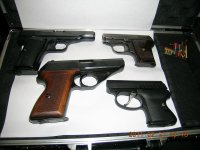
Way back in 1934, Mauser-Werke in Oberndorf am Neckar, Germany, began work on a pocket pistol to compete with the popular Walther PP and PPK series. After 22 prototypes were built and tested, the final version began to be produced in December, 1940. It was called the "HSc." This stands for Hahn Selbstspanner Pistole (hammer self-cocking pistol), version "c."
About 252,000 HSc pistols were produced during WWII, with production ending April 19, 1945. Pistols were issued to the German Navy, Air Force, Army, and the Schutzstaffel (SS). Members of the German military often purchased pistols on their own from commercial production. Most (54%) went to the Army, 11% went to the Navy, 12% went to the Police, and the rest (23%) were commercial production.
After the war, in 1945 and 1946, the French occupied the Mauser factory and produced about 19,000 more HSc pistols, mostly for their military then fighting in French Indochina (now Vietnam).
In 1947, a large part of the Mauser factory was destroyed by the French, and the manufacturing equipment was distributed to the Allied nations.
Mauser re-built its facilities, and then announced that they would resume HSc production in 1967. This they did, making a total of over 63,000 pistols in both .32 and .380 ACP from 1968 through 1977. Production then ceased, the the pistol faded into history.
The action is a bit different from the Walther PP series. The safety, when turned down, does not de-cock the piece. It simply lifts the firing pin up where it cannot be struck by the hammer. When the gun is empty, and the slide is back, whether or not there is a magazine in the gun, the slide stays back. There is no way to release it, as there is no external slide lock. One must re-insert the magazine; as this is done, the slide slams shut, chambering a round if there is one or more in the magazine. This is a most unusual arrangement. As there is a magazine disconnect safety, the gun cannot be fired either single- or double-action without a magazine in place.
The gun is sleek and can be pocketed and withdrawn with no projecting parts that would hang it up. The hammer can pinch the web of the hand if one is not careful to grip it properly. Magazines were made both with and without finger rests, although the finger rest variety is somewhat rare.
I picked this one up at the Mesa, AZ gun show this weekend, and I plan to write an article about it for the Blue Press soon. I thought you'd like to see a picture of it.
John
Last edited:




